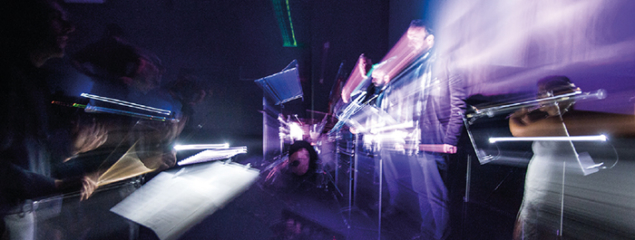
Image credit: CERN.
October 2015 was a turning point for the High Luminosity LHC (HL-LHC) project, marking the end of the European-funded HiLumi LHC Design Study activities, and the transition to the construction phase, which is also reflected in the redesigned logo that was recently presented.

Image credit: Mike Struik, CERN.
So far, the LHC has only delivered 10% of the total planned number of collisions. To extend its discovery potential even further, the LHC will go through the HL-LHC major upgrade around 2025, which will increase the luminosity by a factor of 10 beyond the original design value (from 300 to 3000 fb–1). The HL-LHC machine will provide more accurate measurements and will enable the scientific community to study new phenomena discovered by the LHC, as well as new rare processes. The HiLumi upgrade programme relies on a number of key innovative technologies, such as cutting-edge 12 Tesla superconducting magnets, very compact and ultra-precise superconducting cavities for beam rotation, and 100 m-long high-power superconducting links with zero energy dissipation. In addition, the higher luminosities will make new demands on vacuum, cryogenics and machine protection, and will require new concepts for collimation and beam diagnostics, advanced modelling for the intense beam and novel schemes of beam crossing to maximise the physics output of these collisions.
From design to construction
The green light for the beginning of this new HL-LHC phase, marked by main hardware prototyping and industrialisation, was given with the approval of the first version of the Technical Design Report – the document that describes in detail how the LHC upgrade programme will be carried out. This happened at the 5th Joint HiLumi LHC-LARP Annual Meeting, which took place at CERN from 26 to 30 October and saw the participation of more than 200 experts from all over the world to discuss the results and achievements of the HiLumi LHC Design Study. In the final stage of the more than four-year-long design phase, an international board of independent experts worked on an in-depth cost-and-schedule review. As a result, the total cost of the project – amounting to CHF 950 million – will be included in the CERN budget until 2026.

Image credit: CERN.
In addition to the project management work-package (WP), a total of 17 WPs involving more than 200 researchers and engineers addressed the technological and technical challenges related to the upgrade. During the 48 months of the HiLumi Design Study, the accelerator-physics and performance team defined the parameter sets and machine optics that would allow HiLumi LHC to reach the very ambitious performance target of an integrated luminosity of 250 fb–1 per year. The study of the beam–beam effects confirmed the feasibility of the nominal scenario based on the baseline β* levelling mechanism, providing sufficient operational margin for operation with the new ATS (Achromatic Telescopic Scheme) at the nominal levelling luminosity of 5 × 1034 cm–2s–1, with the possibility to reach up to 50% more. The magnet design activity, focusing on the design of the insertion magnets, launched the hardware fabrication of short models of the Nb3Sn quadrupoles’ triplet (QXF), separation dipole, two-in-one large aperture quadrupole and 11 T dipole for Dispersion Suppressor collimators. Single short coils in the mirror configuration have already been successfully tested for the triplet. The first model of the QXF triplet containing two CERN and two LARP coils was assembled in the US in the summer, and is being tested this autumn, while a short model of the 11 T dipole fabricated at CERN reached 12 T. To protect the magnets from the higher beam currents, the collimation team focused on the design and verification of the new generation of collimators. The team presented a complete technical solution for the collimation in and around the insertions in HL-LHC, providing improved flexibility against optics changes. The crab-cavities activity finalised and launched the manufacturing of the crab-cavity interfaces, including the helium vessels and the cryo-module assembly. All cavity parts stamped in the US will be assembled and surface processed in the US, in addition to electron-beam welding and testing. Last but not least, as part of their efforts to develop a superconducting transmission line, the cold powering activity hit a world-record current of 20 kA at 24 K in a 40 m-long MgB2 electrical transmission line. The team has finalised the development and launched the procurement of the first MgB2 PIT round wires. This is an important achievement that will enable the start of large cabling activity in industry, as required for the production of a prototype cold-powering system for the HL-LHC.
In addition to the technological challenges, the HL-LHC project has also seen an important expansion of the civil-engineering and technical infrastructure at P1 (ATLAS) and P5 (CMS), with new tunnels and underground halls needed to house the new cryogenic equipment, the electrical power supply and various plants for electricity, cooling and ventilation.
A winning combination
Such an extensive technical, technological and civil endeavour would not be possible without collaboration with industry. To address the specific technical and procurement challenges, the HL-LHC project is working in close collaboration with leading companies in the field of superconductivity, cryogenics, electrical power engineering and high-precision mechanics. To enhance the co-operation with industry on the production of key technologies that are not yet considered by commercial partners due to their novelty and low production demand, the newly launched QUACO project, recently funded by the EU, is bringing together several research infrastructures with similar technical requirements in magnet development to act as a single buyer group.







